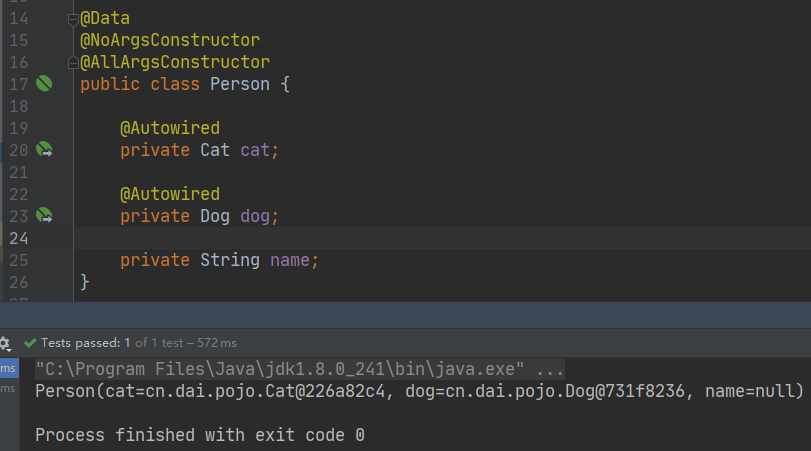1、使用注解实现自动装配
注解的基础源于JDK1.5的新特性
在Spring2.5开始支持了注解功能
如何使用?
1、导入约束
xmlns:context="http://www.springframework.org/schema/context"
1.5、约束坐标
http://www.springframework.org/schema/context
http://www.springframework.org/schema/context/spring-context.xsd
2、配置注解支持
<context:annotation-config />
或者直接复制这个模板
<?xml version="1.0" encoding="UTF-8"?> <beans xmlns="http://www.springframework.org/schema/beans" xmlns:xsi="http://www.w3.org/2001/XMLSchema-instance" xmlns:context="http://www.springframework.org/schema/context" xsi:schemaLocation=" http://www.springframework.org/schema/beans http://www.springframework.org/schema/beans/spring-beans.xsd http://www.springframework.org/schema/context http://www.springframework.org/schema/context/spring-context.xsd " > <context:annotation-config /> </beans>
我们不再容器中编写繁琐的注入,直接在类中完成装配
<bean id="cat33" class="cn.dai.pojo.Cat"/> <bean id="dog22" class="cn.dai.pojo.Dog"/> <bean id="person" class="cn.dai.pojo.Person"/>
@Autowired
既可以在字段上注解
也可以在SETTER上注解
这里使用Lombok,就没有办法在SETTER注解了。。。
Spring可以在没有SETTER方法的情况下,直接对字段进行装配

import org.springframework.lang.Nullable;
@Nullable 被注解的字段或者参数允许为空
//如果允许对象为null,设置required = false,默认为true @Autowired(required = false) private Cat cat;
@Qualifier
@Autowired是根据类型自动装配的,加上@Qualifier则可以根据byName的方式自动装配
@Qualifier不能单独使用。
测试实验步骤:
配置文件修改内容,保证类型存在对象。且名字不为类的默认名字!
<bean id="dog1" class="com.kuang.pojo.Dog"/> <bean id="dog2" class="com.kuang.pojo.Dog"/> <bean id="cat1" class="com.kuang.pojo.Cat"/> <bean id="cat2" class="com.kuang.pojo.Cat"/>
没有加Qualifier测试,直接报错
在属性上添加Qualifier注解
@Autowired
@Qualifier(value = "cat2")
private Cat cat;
@Autowired
@Qualifier(value = "dog2")
private Dog dog;
测试,成功输出!
@Resource
1、@Resource如有指定的name属性,先按该属性进行byName方式查找装配;
2、其次再进行默认的byName方式进行装配;
3、如果以上都不成功,则按byType的方式自动装配。
4、都不成功,则报异常。
实体类:
public class User { //如果允许对象为null,设置required = false,默认为true @Resource(name = "cat2") private Cat cat; @Resource private Dog dog; private String str; }
beans.xml
<bean id="dog" class="com.kuang.pojo.Dog"/> <bean id="cat1" class="com.kuang.pojo.Cat"/> <bean id="cat2" class="com.kuang.pojo.Cat"/> <bean id="user" class="com.kuang.pojo.User"/>
测试:结果OK
配置文件2:beans.xml , 删掉cat2
<bean id="dog" class="com.kuang.pojo.Dog"/> <bean id="cat1" class="com.kuang.pojo.Cat"/>
实体类上只保留注解
@Resource private Cat cat; @Resource private Dog dog;
结果:OK
结论:先进行byName查找,失败;再进行byType查找,成功。
@Autowired与@Resource异同:
@Autowired与@Resource都可以用来装配bean。
都可以写在字段上,或写在setter方法上。
@Autowired默认按类型装配(属于spring规范)
默认情况下必须要求依赖对象必须存在
如果要允许null 值,可以设置它的required属性为false,
如:@Autowired(required=false)
如果我们想使用名称装配可以结合@Qualifier注解进行使用
@Resource(属于J2EE规范)
默认按照名称进行装配,名称可以通过name属性进行指定。
如果没有指定name属性,当注解写在字段上时,默认取字段名进行按照名称查找,
如果注解写在setter方法上默认取属性名进行装配。
当找不到与名称匹配的bean时才按照类型进行装配。
但是需要注意的是,如果name属性一旦指定,就只会按照名称进行装配。
它们的作用相同都是用注解方式注入对象,但执行顺序不同。
@Autowired先byType,@Resource先byName。
完整约束
<?xml version="1.0" encoding="UTF-8"?> <beans xmlns="http://www.springframework.org/schema/beans" xmlns:xsi="http://www.w3.org/2001/XMLSchema-instance" xmlns:context="http://www.springframework.org/schema/context" xmlns:aop="http://www.springframework.org/schema/aop" xmlns:p="http://www.springframework.org/schema/p" xmlns:c="http://www.springframework.org/schema/c" xsi:schemaLocation=" http://www.springframework.org/schema/beans http://www.springframework.org/schema/beans/spring-beans.xsd http://www.springframework.org/schema/context http://www.springframework.org/schema/context/spring-context.xsd http://www.springframework.org/schema/aop http://www.springframework.org/schema/aop/spring-aop.xsd " > <context:annotation-config /> </beans>